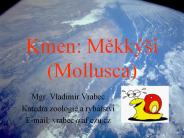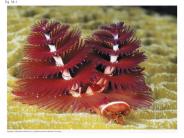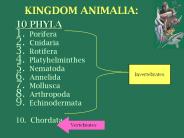Radula PowerPoint PPT Presentations
All Time
Recommended
... use a radula to scrape algae from rocks Carnivores use jaws to eat prey like the octopus Filter feeders use a siphon to catch plankton Gas exchange via ...
| PowerPoint PPT presentation | free to view
Phylum Mollusca Identify Structure Radula Phylum? Common Name? Phylum? Common Name? Phylum? Common Name? Phylum? Common Name? Common Name?
| PowerPoint PPT presentation | free to download
Herbivores: scrape food with radula. Predators: poisonous dart to swallow prey whole ... No distinct head region or radula. Filter feeders. Sperm & egg released ...
| PowerPoint PPT presentation | free to view
Class Bivalvia: clams, scallops, mussels, oysters; shell with two valves; lack radula and head; most marine; foot reduced or used for digging; include shipworms ...
| PowerPoint PPT presentation | free to view
Higher Invertebrates ... specialized feeding organ called a radula in some circulatory system is open ... abdomen (as in insects) cephalothorax (fused ...
| PowerPoint PPT presentation | free to download
Many have a scraping Radula. Trochophore larvae. Molluscan Body Plan. Molluscan Classes ... Scrape algae off rocks with radula. Marine. Gumboot Chiton. Bivalvia ...
| PowerPoint PPT presentation | free to view
They have a thin layer called the Mantel that covers the internal organs and has ... Radula- flexible ribbon of tiny teeth to get food ...
| PowerPoint PPT presentation | free to view
... of Gastropods. Prosobranchs 'gills ... Gastropods radula ... Pelagic Snails: the biology of holoplanktomic gastropod mollusks. Stanford University Press. ...
| PowerPoint PPT presentation | free to view
Why are some animals and plants located in special zones and not all over? ... Scrape food with a radula - tongue with teeth (grazers and carnivores) Sea stars ...
| PowerPoint PPT presentation | free to view
10 pairs of pedal nerves. have radula. Classes of Molluscs: ... aquatic pulmonates surface to expel gas bubble and inhale by curling, thus forming a siphon ...
| PowerPoint PPT presentation | free to view
Molluscs! Soft body, with shell Gills A sticky foot http://www.flickr.com/photos/hershman/709903342/ http://www.flickr.com/photos/jessowen/4694661616/
| PowerPoint PPT presentation | free to download
Phylum Mollusca soft bodied; many with protective shell more species of molluscs in ocean than any other phylum, over 200,000 sp. the mantle is a thin tissue layer ...
| PowerPoint PPT presentation | free to view
ZOO 115 Invertebrate Zoology Mollusca
| PowerPoint PPT presentation | free to download
PowerPoint Presentation ... 5. Molluscs
| PowerPoint PPT presentation | free to download
Molluscs Phylum Mollusca
| PowerPoint PPT presentation | free to download
Snail coming out of its shell (P. bridgesii). Closed shell (P. bridgesii). Pomacea-Asolene, Marisa, Pomacea and Pomella. Depending on the specific snail. all found in ...
| PowerPoint PPT presentation | free to download
Photo credit: MSC A Classroom Lesson from the Mathematics & Science Center Photo credit: NOAA What is a Mollusk? Photo credit: NOAA Mollusks are Animals
| PowerPoint PPT presentation | free to download
Marine, freshwater, and terrestrial habitats. ... Jet-propulsion system. Muscle contractions. Forces water out through narrow funnel. Cuttlefish and squid very motile.
| PowerPoint PPT presentation | free to view
Phylum Mollusca Subphylum Amphineura Class Polyplacophora ... Camb-Perm Class Bivalvia clams, oysters Class Scaphopods tusk shells All major groups ...
| PowerPoint PPT presentation | free to view
(elephantiasis) ...
| PowerPoint PPT presentation | free to download
Title: Whiskey is for drinking and water is for fighting Author: Deanna Marie Combs Last modified by: cestest Created Date: 6/18/2001 7:24:08 PM Document presentation ...
| PowerPoint PPT presentation | free to view
Title: PowerPoint Presentation Author: rafrica Last modified by: Annette Created Date: 7/24/2001 7:31:52 PM Document presentation format: On-screen Show (4:3)
| PowerPoint PPT presentation | free to download
Snails Snails are molluscs. They have soft bodies protected by a hard shell. The body of the snail is usually moist and often slimy. The snail has two pairs of ...
| PowerPoint PPT presentation | free to download
Title: PowerPoint Presentation Last modified by: mklapp Created Date: 12/14/2004 4:35:48 PM Document presentation format: On-screen Show (4:3) Other titles
| PowerPoint PPT presentation | free to download
Page 530 Phylum: Mollusca Snail, oyster, squid, octopus, slug, chiton Characteristics Soft body (yummy part!) Muscular system: Muscular foot (movement) Visceral mass ...
| PowerPoint PPT presentation | free to view
Title: Kmen: M kk i (Mollusca) Author: Milada Opittzova Last modified by: Administrator Created Date: 10/29/2003 8:04:08 AM Document presentation format
| PowerPoint PPT presentation | free to download
MOLLUSKS: Section 27 1 Slugs, snails, and animal that once lived in shells in the ocean or on the beach. Phylum Mollusca Oysters and mussels live firmly attached ...
| PowerPoint PPT presentation | free to download
WHAT IS A MOLLUSK? Why are animals that look and act so different grouped in the same phylum? It is because they share developmental patterns.
| PowerPoint PPT presentation | free to download
Phylum Mollusca Squid External View Squid Internal Anatomy Assignment: Complete Phylum Mollusca handout from last class With your partner, read over the handout for ...
| PowerPoint PPT presentation | free to view
Phylum Mollusca Soft-bodied animals! 3 Classes of Molluscs GASTROPODA : includes limpets, snails, slugs and whelks BIVALVIA: includes clams, oysters, mussels ...
| PowerPoint PPT presentation | free to view
Zoology Chapter 12 Mollusk Ms.K.Cox
| PowerPoint PPT presentation | free to download
Phylum: Mollusca Gastropods, Bivalves & Cephalopods Mollusks Mollusks are soft-bodied animals that usually have an internal or external shell. Ex.
| PowerPoint PPT presentation | free to download
Mussels. Characteristics. Amphineura - Chitons. 8 plates on dorsal surface ... Pelecypoda - Clams, Mussels, Oysters and Scallops. 2 Shells (fairly equal in size) ...
| PowerPoint PPT presentation | free to view
Animal Notes III-Mollusks and Review I Mollusks (Phylum Mollusca) Soft-bodied animals Most are covered by a hard shell (others not) Have a head, foot, and a mass of ...
| PowerPoint PPT presentation | free to download
Phylum Mollusca Chapter 13 Part 1 of 3 General Characteristics Unsegmented Soft bodied critters - Bilateral symmetry Shell formed by mantle secretions Body often ...
| PowerPoint PPT presentation | free to download
Metazoan Invertebrates. Mollusca. Gastropods. Shell and viscera twisted 180 ... Metazoan Invertebrates. Arthropoda Trilobites. Swimming or crawling arthropods ...
| PowerPoint PPT presentation | free to download
... (4,500 species) Ectoprocts A brachiopod Brachiopoda (335 species) Rotifera (1,800 species) A rotifer (LM) A ctenophore, or comb jelly Ctenophora ...
| PowerPoint PPT presentation | free to download
Title: Kingdom Animalia Author: mmarcum Last modified by: Beighle, Kristin Created Date: 1/27/2005 3:40:51 PM Document presentation format: On-screen Show (4:3)
| PowerPoint PPT presentation | free to download
Mollusca - Cobb Learning ... Phylum Mollusca
| PowerPoint PPT presentation | free to view
Reproduction usually external fertilization in the water. ... They move by jet propulsion. Many have an ink sac to distract potential predators.
| PowerPoint PPT presentation | free to view
KINGDOM ANIMALIA: 10 PHYLA Porifera Cnidaria Rotifera Platyhelminthes Nematoda Annelida Mollusca Arthropoda Echinodermata 10. Chordata Invertebrates Vertebrates
| PowerPoint PPT presentation | free to download
Kingdom Animalia Phylum Mollusca Class Polyplacophora Class Scaphopoda Class Bivalvia Class Gastropoda Class Cephalopoda * * * * * * * Most diverse class in Phylum ...
| PowerPoint PPT presentation | free to view
Chitons, tusk shells, snails, slugs, nudibranchs, sea butterflies, clams, ... Shell. Mantle Cavity. Space between mantle and body wall. Contains gills or a lung ...
| PowerPoint PPT presentation | free to view
Phylum Mollusca chitons, clams, snails, slugs, octopi, cuttlefish, squid, & nautili second largest phylum (50,000+ species) well known fossil record
| PowerPoint PPT presentation | free to view
MOLLUSKS Clams, snails, slugs, chitons, octopuses 2nd only to arthropods in # of species Main characteristics of Mollusks Soft body usu. covered by calcium carbonate ...
| PowerPoint PPT presentation | free to view
Class Gastropoda Snails - largest class of molluscs ~ 85,000 living spp. ~ 15,000 fossil spp. Habitats: marine benthos, ocean plankton, freshwater, land
| PowerPoint PPT presentation | free to view
PHYLUM MOLLUSCA Nervous/Sensory System 1. Large brains- good memory, can work thru problems. 2. Complex eye- very similar to human eye. Can form images and ...
| PowerPoint PPT presentation | free to view
Animal Kingdom Pt 3 Dr. James Whitfield
| PowerPoint PPT presentation | free to view
... threadworms, and pinworms Trichinosis is caused by eating undercooked pork containing trichinella spiralis Nematodes Roundworms have a pseudocoelum.
| PowerPoint PPT presentation | free to view
... schizocoelem pseudocoelom Porifera Cnidaria Platyhelminthes Nematoda Mollusca Annelida Echinodermata Chordata ... Generalized Mollusc Anatomy Mantle ...
| PowerPoint PPT presentation | free to view
Animals: The Invertebrates Chapter 25
| PowerPoint PPT presentation | free to download
The Modern fauna - the great carnivore crisis 1. Sepkoski s Curves 2. The Modern fauna 3. Bivalves 4. Ammonites 5. Gastropods 6. Echinoids 7.
| PowerPoint PPT presentation | free to view
Class Bivalvia The Two-Shelled Mollusks Zoology
| PowerPoint PPT presentation | free to view
Chapter 33 Invertebrates are animals without a backbone. The main phyla we will talk about are: Porifera Cnidaria Platyhelminthes Nemotodes Mollusks Annelids ...
| PowerPoint PPT presentation | free to view
... dinoflagellates key link in marine food webs UNIRAMIA Subphylum Uniramia (uniramians) centipedes, millipedes, insects terrestrial UNIRAMIA uniramous appendages: ...
| PowerPoint PPT presentation | free to download
























































